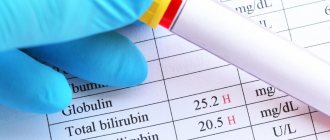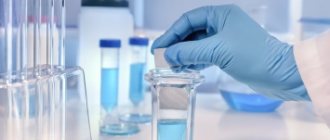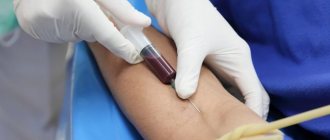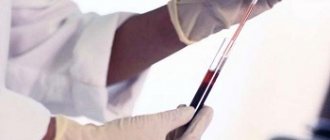What is bilirubin, meaning
The content of the article
The bilirubin molecule consists of 4 pyrrole rings connected to each other. The molecular weight of the molecule is 548.68. Pure bilirubin is a sparingly soluble crystalline substance.
Being a breakdown product of red blood cells, bilirubin is toxic. Its indirect form is constantly formed in tissues and blood and is not excreted from the body. The liver processes the toxic substance and converts it into a direct form that is soluble in water. The direct form is excreted in feces or urine, turning them brown.
Of great importance in diagnosis is the study of the relationship between bilirubin levels in the blood, urine and feces. Even if a blood test shows total bilirubin is normal, but the absolute values and the ratio of pigment fractions have deviations, a differential diagnosis of the disease should be made.
The sum of the fractions can give an overall normal value of total bilirubin, but it often happens that primary bilirubin is elevated and conjugated bilirubin is below normal. This fractional ratio is observed in the initial forms of liver enzyme deficiency and the threat of excessive accumulation of toxic indirect bilirubin in the tissues.
Signs of increased bilirubin
The liver is the main link in the production and removal of bilirubin from the body. Therefore, most diseases that provoke an increase in the amount of pigment in the blood are associated with the liver. In liver pathologies, increased bilirubin manifests itself as follows:
- Discomfort in the right side;
- Nausea, belching after eating (especially after fatty foods);
- Dizziness, loss of strength, bad mood;
- Light stool and dark urine;
- With viral hepatitis, increased body temperature.
The following symptoms are observed in gallstone disease:
- yellowness of the skin and mucous membranes;
- pain in the right side;
- bloating, abnormal stool;
- skin itching.
To failure: how liver diseases progress In the initial stages, liver diseases are completely reversible, but there are conditions when medications are powerless and only a transplant can save the patient’s life.
Bilirubin norms by age
| Type of bilirubin | Children: first 3 days after birth, µmol/l | Children: from 3 to 6 days of life, µmol/l | Children: over 1 month, µmol/l | Adults, µmol/l |
| General | 24 — 190 | 28 — 210 | 3,5 — 20,4 | 8 — 20,5 |
| Straight | 0,5 — 10,2 | 1 — 12,4 | 0 — 5,1 | 0 — 5,1 |
| Indirect | 23,5 — 179,8 | 27 — 197,6 | Up to 16.5 | Up to 16.5 |
Generally accepted norms of indicators
The acceptable level of bilirubin concentration for each age is different. The highest concentration of the substance in the blood is observed in newborns, in the initial stages of life, up to 200 µmol/l, this is due to the period of adaptation of the newborn’s gastrointestinal tract to the digestion of mother’s milk. The acceptable level of bilirubin concentration for each age will be different. The highest concentration of the substance in the blood is observed in newborn children, in the initial stages of life. In one-year-old children and children under 13 years of age, a satisfactory indicator of the concentration of indirect pigment is considered to be up to 20.3 µmol/l, for direct pigment up to 5.2 µmol/l.
The degree of concentration of the substance for adults should not cause concern if the survey analysis shows a level of up to 19.9 µmol/l for indirect, and 4.9 µmol/l for direct bilirubin, since such measurements are satisfactory for people of the adult age category.
Blood test for bilirubin
The outcome of treatment for any disease largely depends on the accuracy of the diagnosis. Quite often, the doctor has to carry out differentiated diagnostics, analyzing the indicators of laboratory, instrumental and instrumental studies, since different diseases may have similar symptoms.
First of all, the doctor focuses on a biochemical blood test due to the universality of the characteristics of this complex test. Among the basic indicators, one of the most important is the content of bilirubin in the blood, which assesses the functioning of the liver, pancreas and gall bladder. The special significance of the “bilirubin” indicator and its relationship with other blood characteristics will be confirmed by any medical forum with numerous questions on this topic.
Increased bilirubin in the blood - what does it mean?
If the test results indicate an increase in bilirubin in the blood, this may indicate the presence of serious diseases and pathological conditions:
- hereditary or caused by other diseases liver enzyme deficiency;
- liver cirrhosis and hepatitis;
- diseases of the biliary tract and gallbladder;
- hemolytic anemia;
- cancer or metastases to the liver from other organs;
- vitamin deficiency B12;
- injuries with multiple hematomas.
An exception is infant physiological jaundice, which occurs due to the restructuring of the newborn’s body after intrauterine development. In all other cases, it is necessary to determine the exact cause of high bilirubin levels.
It is not always possible to identify the true disease based on one indicator, so the doctor compares the values of different indicators, obtaining more detailed information about the pathological process.
How is bilirubin related to other blood parameters?
Bilirubin and hemoglobin
. Hemoglobin and bilirubin are substances connected by a single chain of chemical reactions, which increases interest in comparing their values in blood tests and serves as additional information in diagnosing diseases. Hemoglobin breaks down during the process of red blood cell renewal into globin chains and heme, which is converted by enzymes into toxic indirect bilirubin.
Therefore, high levels of hemoglobin and bilirubin indicate hemolytic anemia or injuries with contusions and bruises with a large number of destroyed red blood cells. If low hemoglobin and high unconjugated bilirubin are observed, then the pathology may be associated with a lack of albumin, which is responsible for moving the yellow pigment to the liver.
Bilirubin and cholesterol
. Increased cholesterol and bilirubin may indicate an incorrect dietary pattern, as a result of which the biliary system suffers, and fatty liver hepatosis is possible. As a rule, such a diagnosis is clarified after considering bile pigment fractions, other indicators from a detailed biochemical blood test, and ultrasound of the abdominal organs.
Diagnostics and tests
To determine what is causing the increase in bilirubin, you need to undergo examination by a specialist. After a visual examination (checking the color of the skin, whites of the eyes, plaque on the tongue) and palpation of the abdominal cavity, the doctor prescribes laboratory diagnostics:
- BAC for the content of direct or indirect bilirubin;
- Aspartate aminotransferase and alanine aminotransferase assay;
- Ultrasound examination of the liver.
Blood sampling may be prescribed for a detailed clinical analysis.
Correct therapy can be prescribed only with an accurate diagnosis. In some cases, the help of an infectious disease specialist and gastroenterologist is required.
Urine tests for bilirubin: bilirubinuria
In healthy people, the urine of the bile pigment bilirubin may be contained in small quantities and is not determined by standard laboratory methods. Therefore, the norm of bilirubin in urine is
is the absence of bile pigment.
Increased bilirubin in urine
In various diseases, direct and indirect bilirubin fractions can be detected in urine samples. This condition is called bilirubinuria.
Indirect bilirubin appears if its content in the blood significantly exceeds the norm and at the same time the permeability of the glomerular membrane is increased. This occurs in the following diseases:
- glomerulonephritis of various etiologies.
- Ga nephropathy (Berger disease)
- systemic lupus erythematosus;
- Henoch-Schönlein purple
- periarteritis nodosa;
- hemolytic-uremic syndrome (HUS);
- idiopathic thrombocytopenic purpura (ITP).
The cause of increased direct bilirubin in urine is jaundice. A positive reaction is detected already in cases where the bilirubin content in the blood is within 30–
34 µmol/l. This indicates a violation of the excretion of bile into the duodenum and an excess of bilirubin in the plasma in adults and children. If the general blood test for bilirubin is normal, there will be no this pigment in the urine.
The presence and absence of this bile pigment in urine in various forms of hepatitis is shown in the table:
| Type of jaundice | Try |
| Normal (healthy person) | Negative |
| Hemolytic | Negative |
| Parenchymatous, at the onset of the disease | Weakly positive |
| Parenchymatous, at the height of the disease | Strongly positive |
| Parenchymatous, in the recovery stage | Weakly positive |
| Obstructive | Positive |
How are tests done for bilirubinuria?
To determine bilirubin in urine, special tests are performed:
Gmelin's test (Rosenbach's modification) is carried out as follows: add 1-2 drops of acetic acid to 100–150 ml of urine and filter the solution several times through a paper filter. After this, the wet filter is left on the Petri dish to dry, after which a drop of a mixture of nitrous and nitric acids is applied to its surface. Increased bilirubin in the urine causes the paper to stain in the form of multi-colored concentric rings, including green, blue, purple, red on the outside and yellow in the center. Without the presence of a green ring, the sample is considered negative.
Rosin's test is carried out by adding a few drops of a 1% alcohol solution of iodine or Lugol's solution to 9–10 ml of urine taken for research. If there are bilirubin fractions in the sample, a persistent, noticeable green ring forms at the liquid interface.
To determine the amount of direct bilirubin fraction, a screening test on standard strips is also used. The level of content of this pigment is determined after applying urine to it and assessing the resulting color using the attached scale.
Testing your urine for the presence of this liver enzyme provides excellent opportunities to:
- for early detection of hepatitis and differential diagnosis of various types of jaundice;
- to determine the effectiveness of treatment in the treatment of many liver diseases;
- in the diagnosis of kidney pathologies accompanied by an increase in the permeability of the glomerular membrane;
- to monitor the presence of pigment in urine during pregnancy and preventive examination of persons working with harmful substances;
- as a quick test for liver condition in patients taking drugs that can cause liver dysfunction.
Urine tests for bilirubin are very simple, but quite informative.
Is jaundice in newborns dangerous?
Neonatal jaundice is common among healthy newborns, and most cases are physiological. In adults and a small proportion of newborns, jaundice is pathological, that is, it means the presence of a disorder that causes it. Some of the most common causes of newborn jaundice include:
Physiological:
- Physiological hyperbilirubinemia.
- Breastfeeding jaundice.
- Breast milk jaundice.
Pathological:
- Hyperbilirubinemia due to hemolytic disease.
- Liver dysfunction (eg, caused by parenteral nutrition causing cholestasis, neonatal sepsis, neonatal hepatitis).
Physiological hyperbilirubinemia occurs in almost all newborns. The shorter lifespan of red blood cells in newborns increases bilirubin production, and low levels of bacterial flora in the intestines (which convert bilirubin into an insoluble form)
in combination with increased hydrolysis of conjugated bilirubin, they increase enterohepatic circulation, as a result of which the liver will not be able to cope with excess incoming bilirubin. As a result, bilirubin levels may rise to 308 µmol/L by 3–4 days of life (by 7 days in Asian infants) and then decline.
Breastfeeding jaundice develops in one sixth of infants during the first week of life. Breastfeeding increases the circulation of bilirubin from the intestines to the liver in some infants who do not consume enough milk and who are dehydrated and calorically deficient.
Jaundice from breast milk is different from jaundice from breastfeeding. It develops after the first 5-7 days of life and reaches a peak after about 2 weeks. It is thought to be caused by increased concentrations of beta-glucuronidase in human breast milk, which causes an increase in the conversion of insoluble bilirubin back to the soluble (unconjugated) form and its reabsorption in the colon.
Still have questions?
Get an online consultation from leading pediatricians in St. Petersburg!
A professional and experienced pediatrician will answer your questions.
Medical care for a child without leaving home at a convenient time.
sign up for a consultation
A Skype consultation lasts 45 minutes.
Stool test for bilirubin
The bile pigment, bilirubin, is normally found only in the stool of very young children who are breastfed. The presence of this pigment in the feces of infants gives the feces a greenish tint. This is an absolutely normal phenomenon and has nothing to do with high bilirubin in the blood of a newborn or newborn and with infantile jaundice, which is characterized by increased indirect bilirubin.
By the fourth month, microflora begins to appear in the baby’s intestines, partially metabolizing this pigment to stercobilinogen, and around nine months this substance is completely metabolized in the intestines to stercobilin and stercobilinogen.
Reasons for the presence of bilirubin fractions in stool
- In older children, positive bilirubin should not be detected in the stool, although small amounts of this substance are sometimes observed in the feces during the first year of a child's life. This is due to the instability and underdevelopment of the children's intestinal microflora.
- In adults in coprogram, bilirubin readings should be negative. Its presence, especially in combination with a decrease in the concentration of stercobilinogen, indicates the existing dysbiosis (overt or hidden) and the presence of pathogenic and microflora in the intestines.
- Another reason for the appearance of this substance in feces is dyspepsia. In the event of gastrointestinal pathologies accompanied by frequent stool disorders, the microflora is “washed out” and traces of bilirubin appear in the stool. This condition is observed in acute and chronic disorders of the gastrointestinal tract or conditions accompanied by impaired digestion of food. In such cases, in a biochemical blood test, the rate of bilirubin fractions is also increased.
- This substance may appear in the results of coprograms in acute poisoning. In this case, the functioning of the gastrointestinal tract and liver is disrupted, due to which the content of bilirubin compounds in the body increases and the evacuation of intestinal contents is accelerated. As a result, a large amount of this pigment enters the intestinal lumen and it leaves the intestine too quickly, not having time to be metabolized into stercobilin and stercobilinogen, and is found in the feces. In this case, indirect bilirubin in the blood is often increased.
How is bilirubin in stool determined?
The content of bilirubin pigment in feces is determined using the Fouche reaction; for this, a reagent is made from 100 ml of distilled water, 25 g of trichloroacetic acid and 10 ml of a 10% ferric chloride solution. A piece of feces is ground with water in a ratio of 1:20 and the reagent is added drop by drop. If there are traces of bilirubin, the test sample turns blue.
The sublimate reaction can also detect the content of bilirubin in feces, but it is less sensitive. To do this, a small lump of feces is ground in a mortar with 3–4 ml of a solution of mercury bichloride (mercuric chloride) and left in a fume hood for a day. The color of stool indicates the presence of bilirubin. Normally, the biomaterial should turn pink or reddish, however, with a positive reaction, the color of the stool turns greenish.
If even a small amount of this pigment is detected in the feces of an adult, consultation with a gastroenterologist and an infectious disease specialist is necessary, especially if at the same time the total bilirubin indicator in the blood test is increased.
Bilirubin bound: what it is responsible for and what it means
Bilirubin is called bound if it has been neutralized in the liver and is bound to glucuronic acid, its normal level in the blood means:
- good liver function;
- sufficient activity of the enzyme that adds glucuronide;
- no obstruction to the flow of bile into the intestines.
The liver is responsible for the formation of direct bilirubin. The source for it is an indirect, very toxic bile pigment, which constantly appears in the blood due to the destruction of “old” (living more than 3 months) red blood cells. It is absorbed by liver cells and, with the help of an enzyme, loses its ability to accumulate in the body, as it becomes water-soluble instead of fat-soluble. Bound bilirubin from the liver tissue normally enters the bile and then into the intestines.
This process is possible only if the pressure in the biliary tract is normal, that is, there is no obstruction to the outflow. In the intestinal lumen, under the influence of bacteria, the pigment is broken down and released with feces, giving it a characteristic brown color. A small amount passes from the intestinal wall into the bloodstream and is filtered through the kidneys, and the urine has a straw-yellow hue.
If there is liver disease with cell destruction or an obstacle to the movement of bile (narrowing of the paths, stone, tumor, thick contents), then direct pigment enters the blood. Then the feces become light and the urine darkens.
When bilirubin increases in the circulatory system, it passes into the tissues of internal organs and skin. This is manifested by yellowing of the skin, mucous membranes, and sclera of the eyeballs. The study of bile pigment is carried out in blood serum. It is necessary to distinguish jaundice due to liver disease or bile stagnation from the accelerated destruction of red blood cells in hemolytic anemia.
Bound and free, indirect, general, conjugated
When obtaining the results of a study of bilirubin metabolism, you need to take into account the meaning of the designations and their synonyms:
- connected is direct, conjugated (from the word conjugation - connection);
- indirect is unbound, that is, free;
- the total is considered as the sum of direct and indirect (bound and free).
The names of direct and indirect bilirubin are explained by the fact that when determining their concentration in the blood, direct, that is, the associated pigment immediately reacts. That is, direct interaction occurs, and for indirect interaction, the addition of a reagent is necessary.
Normal values for adult women and men
The norms for free and conjugated bilirubin in the blood of adult men and women are:
- free (unbound, indirect) – up to 15.4 µmol/l;
- bound (conjugated, direct) – 0-5.6 µmol/l;
- total (sum of direct and indirect) – 5-21 µmol/l.
Different laboratories may use different reagents and measurement methods, so slight deviations from normal bile pigment values may occur. Therefore, the range of acceptable bilirubin levels is always indicated on the form next to the result obtained. Many diagnostic institutions indicate total and direct, and indirect is calculated as the difference of these numbers.
What are the child’s indicators?
For a newborn child, direct bilirubin levels are slightly higher than for an adult, since the remaining immature red blood cells of the fetus are rapidly destroyed. If there is yellowing of the skin (jaundice), then the total pigment grows due to indirect. Acceptable values for bound bilirubin in µmol/l:
- from 1 day to the end of 2 weeks – 5.7-12.1;
- up to 1 year – 0-5.2;
- from one year to 9 years – less than 3.4;
- from 9 years old to 13 – up to 5;
- teenagers from 13 to 19 years old: boys 1.7-7.1, and girls 1.7-6.7;
- from 19 years old not higher than 5.6.
Bilirubin and acute and chronic liver failure (hepatargia)
Liver failure occurs with pronounced changes in the liver parenchyma (fibrous, dystrophic or necrotic). Depending on the speed of occurrence, acute and chronic forms are distinguished.
With hepatargia, the detoxification function of the liver sharply decreases, due to which endotoxins, which should have been eliminated, penetrate into the blood and cause poisoning of the body. In the blood, direct and total bilirubin increases to critical levels (260–350 µmol/l), which causes damage to the central nervous system. The mortality rate is 50–80%. Liver failure can be acute or chronic. The degree of danger is determined through tests for bilirubin.
Causes of hepatargia
- The condition is often a consequence of the development of viral hepatitis and liver cirrhosis. In this case, the presence of slowly progressive hepatargia is characteristic. Hepatitis and cirrhosis can be asymptomatic for a long time, and the norm of direct bilirubin in the blood may not be exceeded for a long time;
- Sometimes the cause is infection of a person with Epstein-Barr viruses, herpes, adenovirus, etc. When a woman is infected with cytomegalovirus, intrauterine infection of the fetus occurs and its death. In this case, total bilirubin is increased during pregnancy.
- The most common cause of this condition is exposure to poisons and medications. In some cases, poisoning occurs due to the use of drugs in the wrong dosage, and sometimes it is a consequence of a failed suicide. In this case, the process develops acutely and is accompanied by nausea, vomiting, hemorrhagic syndrome, “hepatic” bad breath, neuropsychiatric disorders, and increased total bilirubin in the blood.
- Very often this condition is associated with the presence of malignant tumors in the body. Both the main focus and metastasis to this organ can be observed in the liver. In cancer, symptoms increase gradually, accompanied by severe jaundice, nausea, vomiting and cachexia. At the beginning of the development of the tumor process, there may be a normal level of bilirubin - 7-18%, but gradually its concentration in the blood increases and it begins to exceed the norm by 10-15 times.
- Another cause of liver failure is alcohol and drug abuse. In this case, the process can proceed either quickly or slowly, it all depends on the specific version of the “predilection”. However, over time, the increased bilirubin still exceeds the norm many times over.
Symptoms of hepatargia
With this pathology, they gradually increase; jaundice, edema, weight loss, fever, telangiectasia, and dull abdominal pain. “Liver signs” appear on the body: palmar erythema, hemorrhages, Chistovich’s stars, varicose veins of the abdomen in the form of a “jellyfish head”.
Later they are joined by: severe bad breath, neurosis, apathy, and unstable emotional state. Slurred speech, writing problems, finger tremors, and poor coordination may occur. A general blood test and biochemistry show significant deviations from the norm.
With further progression of failure, hepatic coma occurs. Its precursors are: drowsiness, lethargy, rigidity of skeletal muscles, confusion, muscle twitching, convulsions, uncontrolled urination. Very high levels of liver tests are observed in the blood. A general blood test for bilirubin can show up to 500 µmol/l. Patients fall into a coma and die.
In order not to become victims of this disease, you need to take care of your liver, monitor your health, periodically get tested, and if the biochemistry is “bad” and total bilirubin is increased, the reasons for this phenomenon need to be found out. You should not self-medicate, because only a doctor knows exactly what bilirubin and other blood parameters should be.
References
- Clinical guidelines “Drug-induced liver damage”, 2019. - 35 p.
- Pakhomova, R.A., Kochetova, L.V. Clinical manifestations of obstructive jaundice and liver failure, depending on the severity of obstructive jaundice of benign origin.” — Modern problems of science and education, 2021. — No. 6. — P.47.
- Sullivan, J., Rockey., D. Diagnosis and evaluation of hyperbilirubinemia. — Current opinion in gastroenterology, 2021. — Vol. 33(3). — P. 164-170.
Physiological and pathological jaundice in newborns
Jaundice (jaundice) in newborns is associated with the breakdown of fertile hemoglobin in the first days of life. It can be physiological and pathological. With physiological jaundice, its manifestations go away on their own and the general condition of the newborn does not suffer. The concentration of total bilirubin is normal in children in this case; it increases only due to its unbound fraction. To determine the extent of the problem, children are tested for bilirubin.
Severe physiological jaundice
If the norm of free bilirubin is significantly exceeded, the general condition of the child may suffer. Such babies are lethargic, lethargic, suck poorly, they may develop a fever and vomit. However, the condition of the newborn should be judged not by these signs, but by the bilirubin level.
When total bilirubin in newborns exceeds the norm significantly, albumin produced by the children's liver cannot completely conjugate it and it penetrates the central nervous system through the blood-brain barrier. In this case, this pigment, which is, in fact, poison, has a toxic effect on the brain. As a result, the baby may subsequently develop paralysis, mental retardation, deafness and blindness.
How to distinguish physiological jaundice from pathological?
Jaundice that develops in the first 24-48 hours of life or persists longer than 2 weeks is most likely pathological.
Jaundice that does not appear until 2–3 days of life is most likely physiological.
An exception is pathological jaundice due to Crigler-Najjar syndrome, hypothyroidism or drug exposure, which also manifests itself after 2-3 days. In this case, the bilirubin concentration peaks in the first week, increasing at a rate of up to 86 µmol/L per day, and may persist for a long period.
Treatment of jaundice
In order to prevent such complications, in case of severe and protracted jaundice, it is necessary to carry out specific treatment.
Previously, children were infused with various solutions to normalize bilirubin levels, but this has now been abandoned. Now light therapy is carried out, during which the newborn’s skin is illuminated with a special installation. Under the influence of light, the pigment decomposes and is removed from the body. Such children are monitored by neonatologists until direct bilirubin returns to normal. Most often, it is possible to normalize bilirubin in 9 days or less.
A great way to overcome jaundice is to start breastfeeding your baby as early as possible, because colostrum helps to pass meconium and cleanse the newborn’s intestines.
It has been noted that this condition is more often observed in children born prematurely, with multiple pregnancies and difficult births. Children born to mothers suffering from chronic diseases such as diabetes are susceptible to jaundice. Contrary to popular belief, an increased bilirubin level in the mother during pregnancy and yellowing of the skin in the newborn baby are absolutely unrelated.
Bilirubin tests reveal pathological jaundice
This type of pathology in newborns manifests itself in the first days of life. Such a baby may have: acholic feces, dark urine, hemorrhages and bright yellowness of the skin and sclera. In contrast to physiological hyperbilirubinemia, when it occurs pathologically, the norm of direct bilirubin in the blood is noticeably exceeded. In this case, a comprehensive examination and treatment is necessary.
The causes of the phenomenon are most often known:
- Incompatibility of the blood of mother and baby by group and Rh factor can cause hemolysis of red blood cells and icteric staining of the sclera of the newborn.
- Sometimes a child becomes infected with the hepatitis virus or protozoa from the mother and develops an infection. In this case, specific therapy is carried out for mother and baby, since the rate of total bilirubin in a woman is also increased in this case due to infection.
- Due to congenital abnormalities of the liver and biliary tract, obstructive jaundice may occur, characterized by an increase in direct bilirubin levels by 6 or more times. Only surgeons can help here.
- There is a large group of hereditary hyperglobulinemias (Crigler-Najjar, Dabin-Johnson, Rotor syndromes), which are caused by genetic metabolic defects. In this case, you need to prepare for long-term diagnostics and lifelong maintenance therapy.
Only a doctor can accurately diagnose jaundice in newborns and find out its cause. The diagnosis can only be made based on test results.











